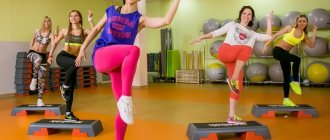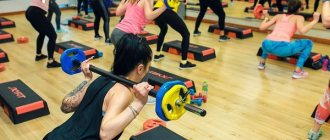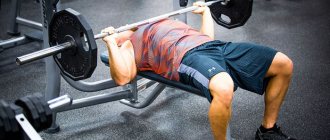Save for yourself so as not to lose:
- Steppers are different...
- What muscles can be trained by working out on a stepper?
- What causes weight loss?
- What else is useful for training on a stepper?
- Training option for beginner athletes
Dreaming of losing extra pounds and getting an ideal figure, many people buy cardio equipment for home. And, as often happens, after a couple of classes, interest in training disappears. After all, without a well-structured exercise program, it is impossible to achieve results and get into a training rhythm. We invite you to learn how to properly exercise at home on one of the most popular cardio equipment - the stepper. In this article we will tell you how athletes with different levels of training should train. Let's discuss the technique of doing the exercises. We will give recommendations on how much you need to exercise in order to lose weight and achieve a beautiful body contour.
Steppers are different...
However, first of all, you need to become familiar with the different types of steppers. After all, each of them has its own special operating principle and list of functionality.
- Classic steppers. This category includes exercise machines whose movements imitate climbing a regular staircase. Some models have additional design elements necessary to work out the muscles of the arms, shoulder girdle, and back. These are racks, levers, expanders.
- Ministeppers. Compact exercise machines that are convenient to use in conditions of limited free space. Such steppers are often chosen for homes, offices, and cottages: they are easy to store, transport, and use. If you want to load the muscles of the upper body, you can do exercises with your arms while exercising on the machine. Does it seem like this is not enough? Work with weights - for example, pick up dumbbells.
- With a rotating handle, or rotary steppers. Such exercise machines help strengthen the abs, oblique abdominal muscles and back muscles. The result of regular training is minus a few centimeters in the abdomen and sides, the formation of a slender waist. And all because while practicing on a rotary stepper, the user has to not only step, but also turn the upper part of the body, moving along with the rotating handle.
- Elliptical steppers. A hybrid of two cardio exercise machines at once. Such devices combine the best features of a stepper and an ellipsoid. Almost the entire body is involved in the work, which allows you to burn calories more efficiently. Another important nuance is that when working out on an elliptical stepper, you practically do not load your knee joints. Therefore, this training format is suitable even for older people and those who suffer from excess weight.
Types of steppers and their features
Choosing a stepper simulator based on size? Steppers are classified as:
- Standard steppers . Such exercise machines are distinguished by a more massive design with handrails or levers, with the help of which the load is distributed evenly over the entire back.
- Mini version of the stepper . This design is more simplified, representing a device with pedals. There are varieties that come with expanders, which also allow you to load your back and arms.
The last option is considered optimal if you decide to train at home. It will cost less and won’t take up much space. But there are other types of these cardio equipment:
- Classic typeA. The effectiveness of this type of stepper is obvious, because it exactly simulates climbing stairs.
- Balancing. This device is more complex, because the platform moves during exercise, thereby changing the center of gravity. Thus, it works for a person more muscles, including the abs. Of course, you need to adapt to it first, because at first it will not be easy to practice on it, but the result is worth it. And how many calories the stepper burns is simply a miracle!
- Rotary type. The design of this device allows load your back well person during classes. The classes are quite intense, so you need to be prepared to “sweat.” What muscles does a stepper of this type work? Trapezoidal, diamond and square.
Steppers also differ in design . Today, there are several types of devices: professional, folding and stand-alone . Naturally, the first type of stepper is intended for installation in gyms, so their design is distinguished by the greatest strength and dimensions. Self-contained steppers can be battery-powered, so they can be used at home. The same applies to folding steppers, but their durability leaves much to be desired, so you can forget about intense training.
The differences don't end there. There is a mechanical type of device, which is more suitable for home use, and an electromagnetic one , intended for installation in gyms and fitness centers. The principle of operation of mechanical steppers is quite simple: it is based on hydraulics, i.e. a person presses on one pedal, after which the cylinder compresses, and when he begins to press on the other, the cylinder unclenches. As for electromagnetic devices, they are more technically complex and include console control with certain functions and training programs.
What causes weight loss?
The benefits of cardio training for weight loss are explained quite simply. To understand how excess fat is burned, you need to follow the stages of the process. During cardio training, we stimulate blood circulation. And the more blood passes through the heart, the more oxygen our body receives, which is a natural fat burner. Thus, cardio exercises help reduce the layer of subcutaneous adipose tissue.
Interesting fact: in a half-hour session on a stepper you can burn about 300 calories. To increase your calorie burn and burn 400 kcal already, load your arms and upper body, for example, using machine levers, expanders or dumbbells.
What else is useful for training on a stepper?
- The functioning of the lungs and the entire respiratory system is normalized;
- The walls of blood vessels are strengthened;
- Metabolism accelerates;
- Coordination of movements improves;
- Endurance develops;
- Cellulite is reduced.
However, if you want to achieve this effect, do not forget to follow the rules of effective, safe exercise.
What do you need to remember when practicing on a stepper?
It is important to adhere to three basic rules:
- Exercise regularly
- Monitor the load and adjust it if necessary,
- Don't forget about the technique of doing the exercises.
Let's take a closer look at each point.
To achieve your goals in losing extra pounds, exercise on a stepper regularly - 3-4 times a week. Take a break of one day between workouts. This is the optimal period, which is enough for the loaded muscles to rest a little, but not completely relax.
Before getting on the machine, be sure to warm up. Perform basic exercises to warm up the main muscle groups. You can jump rope, run at a moderate pace, and perform joint rotations. Allow 5-10 minutes to warm up.
You need to finish your cardio workout with a so-called cool-down. That is, a short stretch that helps slow down the pace of the workout and relax the worked muscles. Some skip this stage, considering it optional. Don't make this mistake! Keep in mind that a cool-down helps consolidate the positive results of your workout.
However, you should not be overzealous in trying to stretch your muscles. Move smoothly, without jerking, until the sensations are tolerable, do not allow acute pain.
Adequately calculate the load and duration of training that is comfortable for you.
Beginners are recommended to practice on the stepper for about 15-20 minutes at first (this includes warm-up and cool-down). Gradually you need to increase the duration of training. After a month, your lesson may already last about an hour.
In the fitness industry, there is the “25-minute rule,” which states that for the first 25 minutes of a workout, our body draws energy from blood sugar (carbohydrate glycogen from tissue cells). And only after that it begins to use fat reserves. That is, the process of fat breakdown literally occurs, which leads to weight loss.
It happens that some athletes make walking on a stepper the final part of their strength training. In this case, it will be enough to work out on the simulator for 20 minutes. And here it is important to remember to gradually reduce the pace.
Monitoring your heart rate helps you maintain the right level of exercise. Many stepper models have built-in heart rate sensors. If your simulator does not have this option, make sure to purchase a separate heart rate monitor.
Training option for beginner athletes
Let's imagine that you have already done your warm-up and are moving directly to the stepper exercise.
- To begin, walk at a calm pace for about 5 minutes.
- Then gradually increase your speed, moving to a medium walking pace - this will take you 4 minutes. And move as quickly as possible for 1 minute. Repeat this session 4 times.
- We finish our stepper exercises with a 5-minute walk at a calm rhythm and begin stretching.
Have you decided to work out your arm muscles while walking on a machine? Here are some effective exercises with expanders or dumbbells:
- Raise your arms to the sides to shoulder level;
- Raise your arms forward to shoulder level;
- do biceps curls;
- we move our hands back to the triceps;
- we raise our hands up in front of us;
- We make a “scissors” movement, keeping our hands at shoulder level.
Steppers: characteristics, types, types
Various models of steppers are able to inform the user about certain data. Among which are the simplest ones in the form of training time, distance, speed, step frequency, number of steps, heart rate measurement, calorie consumption, power output; and more advanced ones such as training chart, recovery test, fat analyzer, body mass index (BMI), basal metabolic rate (BMR), etc. — Training time. The display of training time can include both a total time counter and specialized functions - for example, the time spent in the “target zone” (working at a certain heart rate that is optimal for a particular mode), the total training time for the day/week/month, etc. .P. Specific features vary from model to model.
- Distance. Displaying the “distance traveled” - the distance the user has conventionally covered during the workout. By default, this function displays the distance traveled since the simulator was turned on, however, some models may provide more advanced functions - for example, summation over a certain period of time
- Speed. Display... the conditional speed of the athlete’s movement (that is, the speed that would give the same load as working on a stepper at the current moment). Usually there is a function to display the current speed, but some models can also calculate the average speed of the distance - this provides additional opportunities for monitoring loads and tracking progress.
— Stepping frequency. Displays the frequency of steps taken (in fact, the frequency of clicks on platforms). Generally similar to speed information (see above) and also useful for load accounting and analysis.
— Number of steps. Displays the total number of steps taken by the user. In the simplest models, steps are counted from the moment they are turned on; in more advanced options, summation over a certain period, calculation of the average number per workout and other additional features may be provided.
— Pulse measurement. Possibility of measuring the athlete's heart rate during training. This parameter is one of the most important when doing any serious work on the simulator, because for different purposes (burning fat, maintaining tone, strengthening the cardiovascular system), the optimal heart rate will be different. It also depends on a number of other parameters: gender, age, physique, physiological characteristics, etc. And exceeding the maximum permissible heart rate is fraught with unpleasant consequences for health. You can find out more about this in specialized literature, and it is best to consult a trainer or doctor. To measure the pulse, special sensors are used; in different models of steppers they can have a different design: a clip on the ear, a chest unit with a belt, sensitive plates on the handrails, etc.
- Calorie consumption. Displays the amount of energy expended by the athlete during the training process. This allows you to evaluate the effectiveness of the work to a certain extent, especially if it is aimed at burning fat and you need to track energy costs. Let us note that in most steppers the estimation of calorie consumption is done rather approximately, without taking into account the individual characteristics of the body, but for amateur training this accuracy is quite sufficient.
— Recovery test. The presence of a recovery test function (also called a “fitness test” or “fitness assessment”) allows you to determine the rate of recovery of the body after physical activity and, accordingly, its general physical condition and adaptability to such stress. Usually, for this purpose, the pulse is measured twice - immediately after training and 1 minute later - after which the simulator gives an assessment, which is deciphered using special tables. Trainers with a recovery test function by definition have the ability to measure heart rate (see above).
- Calorie consumption. Displays the amount of energy expended by the user during the workout. This allows you to evaluate the effectiveness of the work to a certain extent, especially if it is aimed at burning fat and you need to track energy costs. Note that in most models, the estimation of calorie consumption is done rather approximately, without taking into account the individual characteristics of the body, but for amateur training this accuracy is quite sufficient.
— Power generated. The display shows information about how much electricity, in Watts (W), was generated during the workout. Experienced users use this data to evaluate the overall level of effectiveness/effectiveness of the workout. Once a certain amount of power generated is reached, you can end the workout.
— Training diagram. The screen displays a graph of the training program, on which the load level and duration of the workout are recorded in a convenient form. The diagram allows you to visually assess the amount of effort expended, and at the same time the calories burned, at various stages of the lesson. Additionally, this allows you to take control of the pace of the load. A decreasing or increasing graph will tell you when it is advisable to increase the load and when to reduce it, in order to evenly distribute the forces throughout the training program.
— Fat analyzer. The operation of the fat meter is based on the use of a weak electric current passed through the human body: different types of human tissue have different resistance, and the amount of fat tissue can be deduced from the characteristics of the discharge. This technology is not accurate, but to a certain extent it allows you to assess body features; and by measuring the fat content before and after a course of training, you can get a fairly clear result. The measuring current is considered harmless to healthy people, but has a number of limitations.
— Body mass index (BMI). Automatic calculation of body mass index allows you to adjust training modes for each individual user, as well as more objectively evaluate the results of training programs. Body mass index (BMI) is the ratio of a person's height to their weight. Calculated using the following formula: weight / height / height. Let's assume that the user weighs 70 kg and is 1.76 m tall. In this case, BMI = 70/1.76/1.76 = 22.6. The normal MBI index is considered to be from 19 to 24. If the user’s MBI is insufficient (less than 19), then the simulator will develop workouts with the expectation of gaining body density and increasing muscle mass. When the MBI is excessive (over 24), the simulator will recommend using a training program to reduce fat mass.
— Estimation of basal metabolic rate (BMR). The ability to calculate basal metabolism - the minimum amount of energy required by the body for normal functioning (for the functioning of the respiratory, circulatory, nervous system, as well as various organs). In other words, basal metabolism is the amount of energy that the body spends directly on functioning, without storing it “for later” in the form of adipose tissue. This parameter is extremely important for organizing proper nutrition, especially when exercising to burn fat and lose excess weight. There are formulas that allow you to determine BMR based on a person’s weight, height, age, and gender; however, they only allow you to get an average result, while the simulator is able to take into account many additional factors that affect the metabolic rate. As a rule, basal metabolism is determined by energy expenditure per day.
— Room temperature. Possibility of measuring and displaying the room temperature on the stepper display. This function will help you more accurately assess the conditions for training and choose the appropriate form of clothing, as well as, if necessary, take measures to ensure a comfortable temperature (open the window; turn on the air conditioner - or vice versa, the heater).
The above list is not exhaustive; in modern orbitreks, other types of information can be displayed on the display.










